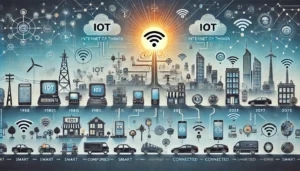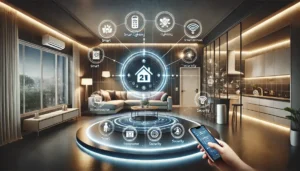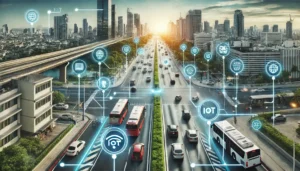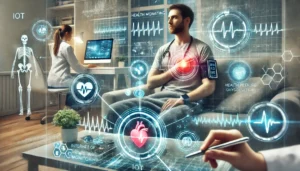AI and the Internet of Things: Creating Smart Homes and Cities

The combination of Artificial Intelligence (AI) and the Internet of Things (IoT) is transforming the way we live in cities and homes. This article explores how these technologies work together to create smarter living spaces and urban environments, offering benefits such as increased efficiency, sustainability, and safety. As we delve into the future of smart homes and cities, we will highlight key trends, challenges, and opportunities that arise from this technological evolution.
Key Takeaways
- AI and IoT work together to create smarter homes and cities.
- Smart homes improve energy efficiency and enhance security.
- IoT devices help manage urban resources like traffic and waste.
- AI can predict trends and improve service delivery in cities.
- Sustainability is a major focus in developing smart cities.
The Evolution of the Internet of Things in Modern Society
Historical Background of IoT
The concept of the Internet of Things (IoT) has its roots in the early days of the internet. In the 1980s, researchers began to connect devices to the internet, allowing them to communicate. This laid the groundwork for the smart devices we use today. Over the years, the technology has evolved significantly, leading to the interconnected world we now experience.
Key Milestones in IoT Development
Several key milestones have marked the development of IoT:
- 1999: The term “Internet of Things” was coined by Kevin Ashton.
- 2005: The International Telecommunications Union published a report on IoT.
- 2010: The first IoT devices became commercially available.
These milestones highlight the rapid growth and adoption of IoT technologies.
Current Trends in the Internet of Things
Today, we see several exciting trends in IoT:
- Increased connectivity: More devices are being connected to the internet than ever before.
- AI integration: Artificial intelligence is enhancing the capabilities of IoT devices.
- Focus on security: As IoT grows, so does the need for robust security measures.
The evolution of IoT is not just about technology; it’s about creating a more connected and efficient world for everyone.
In conclusion, the journey of IoT from its inception to its current state is a testament to human innovation. We are excited to see where this technology will take us next!
How AI Enhances IoT (Internet of Things) Capabilities
In today’s world, the combination of AI and IoT is transforming how we interact with technology. AI significantly boosts the capabilities of IoT devices, making them smarter and more efficient. Here’s how:
AI and Machine Learning in IoT
AI and machine learning allow IoT devices to learn from data. This means they can adapt to our needs over time. For instance, smart thermostats can learn our preferences and adjust temperatures automatically. This not only enhances comfort but also saves energy.
Predictive Analytics and the Internet of Things
Predictive analytics is another area where AI shines. By analysing data from various sources, AI can predict future trends. For example, in smart cities, traffic patterns can be predicted, helping to reduce congestion. This leads to smoother commutes and less frustration for everyone.
AI-Driven Automation in Smart Devices
Automation is a key benefit of integrating AI with IoT. Smart devices can perform tasks without human intervention. For instance, smart irrigation systems can water gardens based on weather forecasts, ensuring plants receive the right amount of water without wasting resources.
In summary, the synergy between AI and IoT is paving the way for a more efficient and sustainable future.
The integration of AI into IoT is not just a trend; it’s a necessity for smarter living.
| Capability | Description |
|---|---|
| AI Learning | Devices adapt to user preferences over time. |
| Predictive Analytics | Anticipates future trends based on data analysis. |
| Automation | Devices perform tasks without human input. |
By embracing these technologies, we can create a more connected and efficient world.
Smart Homes: The Future of Living
In today’s world, smart homes are becoming increasingly popular. They offer us comfort, security, and energy efficiency. Imagine controlling your home from anywhere in the world! With smart devices, we can manage everything from lighting to security systems with just a few taps on our smartphones.
IoT Devices in Smart Homes
Smart homes are equipped with various Internet of Things (IoT) devices. Here are some common examples:
- Smart thermostats
- Smart lights
- Security cameras
These devices work together to create a seamless living experience. They can learn our habits and adjust settings automatically, making our lives easier.
Energy Efficiency and Smart Homes
One of the biggest advantages of smart homes is energy efficiency. By using smart technology, we can:
- Monitor energy consumption
- Reduce waste
- Save on utility bills
For instance, smart thermostats can adjust heating and cooling based on our daily routines, ensuring we only use energy when needed.
Security and Privacy in Smart Homes
While smart homes offer many benefits, they also raise concerns about security and privacy. We must ensure that our devices are secure to prevent unauthorised access. Here are some tips to enhance security:
- Use strong, unique passwords
- Regularly update device software
- Enable two-factor authentication
In conclusion, smart homes represent a significant step towards a more connected and efficient future. By embracing this technology, we can enjoy a more comfortable and secure living environment.
Building Smart Cities with the Internet of Things
In our journey towards creating smarter cities, the Internet of Things (IoT) plays a pivotal role. Smart cities integrate technology to enhance urban living. By connecting various devices, we can gather data that helps us make informed decisions.
Urban Planning and IoT
Urban planning is evolving. With IoT, we can:
- Monitor traffic patterns in real-time.
- Manage public resources efficiently.
- Enhance public transport systems.
These advancements lead to better infrastructure and improved quality of life for residents.
Public Safety and the Internet of Things
Safety is paramount in any city. IoT devices can:
- Detect emergencies quickly.
- Provide real-time alerts to citizens.
- Monitor environmental conditions to prevent disasters.
By leveraging these technologies, we can create safer urban environments.
Sustainable Development in Smart Cities
Sustainability is at the heart of smart city initiatives. IoT helps us:
- Reduce energy consumption through smart grids.
- Manage waste more effectively.
- Promote green spaces and biodiversity.
In conclusion, the integration of IoT in urban planning not only enhances efficiency but also fosters a sustainable future.
As we embrace these technologies, we must remain vigilant about data privacy and security.
In this exciting era, we are witnessing the transformation of our cities into smart, connected environments that benefit everyone.
PPC ecommerce agency strategies can also be applied to promote these innovations effectively, ensuring that the public is informed and engaged in the process.
The Role of the Internet of Things in Transportation
In today’s world, the Internet of Things (IoT) is transforming how we think about transportation. We can see its impact in various areas, from traffic management to public transport systems. IoT is not just a buzzword; it’s a game-changer for urban mobility.
Smart Traffic Management
IoT devices are crucial for managing traffic flow. They collect real-time data from sensors placed on roads and traffic lights. This data helps in:
- Reducing congestion
- Optimising traffic signals
- Enhancing road safety
For instance, cities can adjust traffic light timings based on current traffic conditions, leading to smoother commutes.
Public Transport Systems
Public transport is becoming smarter thanks to IoT. Buses and trains are equipped with sensors that provide real-time updates to passengers. This includes:
- Arrival times
- Seat availability
- Service disruptions
Such information helps commuters plan their journeys better, making public transport a more attractive option.
Autonomous Vehicles
The future of transportation is also leaning towards autonomous vehicles. These vehicles rely heavily on IoT technology to:
- Communicate with each other
- Monitor their surroundings
- Make real-time decisions
This technology promises to reduce accidents and improve traffic efficiency.
As we embrace IoT in transportation, we are paving the way for safer, more efficient, and environmentally friendly travel options.
In conclusion, the role of IoT in transportation is significant. It enhances our daily commutes and contributes to smarter cities. We are excited to see how this technology will continue to evolve and shape our urban landscapes.
Energy Management in Smart Cities
In the context of smart cities, energy management is crucial. We can harness the power of AI and IoT to optimise energy usage. By analysing data from various sources, we can identify where energy is wasted and where renewable sources can be deployed effectively.
Smart Grids and the Internet of Things
Smart grids are a game changer. They allow for real-time monitoring and management of energy resources. Here are some key benefits:
- Improved efficiency in energy distribution.
- Enhanced ability to integrate renewable energy sources.
- Better response to energy demand fluctuations.
Renewable Energy Integration
Integrating renewable energy into the grid is essential for sustainability. We can achieve this through:
- Solar panels on rooftops.
- Wind turbines in urban areas.
- Energy storage systems to balance supply and demand.
Energy Consumption Monitoring
Monitoring energy consumption helps us make informed decisions. We can use IoT devices to track usage patterns and identify areas for improvement. This data can lead to:
- Reduced energy costs for residents.
- More sustainable urban planning.
- Enhanced public awareness about energy conservation.
By leveraging technology, we can create a more sustainable future for our cities.
In conclusion, energy management in smart cities is not just about saving costs; it’s about creating a sustainable environment for future generations. We must embrace these technologies to ensure a greener tomorrow.
Healthcare Innovations Through the Internet of Things
Remote Patient Monitoring
In today’s world, remote patient monitoring is revolutionising healthcare. We can now track patients’ health from the comfort of their homes. This technology allows us to collect vital health data continuously. This means quicker responses to health issues.
Internet of Things in Medical Devices
Medical devices are becoming smarter. They can now connect to the internet, providing real-time data to healthcare professionals. This connectivity enhances the accuracy of diagnoses and treatments. For instance, wearable devices can monitor heart rates and alert doctors if something is wrong.
Data Security in Healthcare IoT
While the benefits are immense, we must also consider data security. Protecting patient information is crucial. We need to implement strong security measures to prevent data breaches. Here are some key points to consider:
- Use encryption for data transmission.
- Regularly update software to fix vulnerabilities.
- Educate staff on data protection practises.
In conclusion, the integration of IoT in healthcare is not just about convenience; it’s about improving patient outcomes and ensuring safety. We must embrace these innovations while prioritising security and privacy.
Challenges in Implementing the Internet of Things Solutions
As we explore the integration of IoT into our daily lives, we must acknowledge the significant challenges that come with it. These hurdles can hinder the smooth adoption of IoT technologies in both smart homes and cities.
Data Privacy Concerns
One of the foremost issues we face is data privacy. With countless devices collecting personal information, the risk of data breaches increases. We must ensure that robust security measures are in place to protect user data. This includes:
- Implementing strong encryption methods
- Regularly updating software to patch vulnerabilities
- Educating users about safe practises
Infrastructure Requirements
The successful deployment of IoT solutions requires a solid infrastructure. Many regions lack the necessary technological backbone, which can lead to inconsistent service. Key infrastructure needs include:
- Reliable internet connectivity
- Sufficient power supply
- Advanced data processing capabilities
Interoperability Issues
Another challenge is the lack of standardisation among devices. Different manufacturers often use varying protocols, making it difficult for devices to communicate effectively. To overcome this, we need:
- Common standards for device communication
- Collaboration between tech companies
- Development of universal APIs
Addressing these challenges is crucial for the successful implementation of IoT solutions. By focusing on security, infrastructure, and interoperability, we can pave the way for a smarter future.
In conclusion, while the potential of IoT is immense, we must tackle these challenges head-on to fully realise its benefits in our homes and cities. Only then can we create a truly connected world.
The Future of the Internet of Things: Opportunities and Predictions
Emerging Technologies in IoT
The future of the Internet of Things (IoT) is bright, with emerging technologies paving the way for innovative solutions. We can expect advancements in areas such as:
- 5G connectivity: This will enhance data transfer speeds and reduce latency.
- Edge computing: Processing data closer to the source will improve response times.
- Blockchain: This technology can enhance security and data integrity.
Market Growth and Trends
The IoT market is projected to grow significantly. According to recent estimates, the global IoT market could reach $1.1 trillion by 2026. This growth is driven by:
- Increased adoption of smart devices.
- Rising demand for automation in various sectors.
- Enhanced focus on sustainability and energy efficiency.
Future Applications of IoT (Internet of Things)
We envision a future where IoT applications will transform our daily lives. Some potential applications include:
- Smart healthcare: Remote monitoring and telemedicine will become commonplace.
- Agricultural innovations: IoT can help farmers monitor crops and manage resources efficiently.
- Smart cities: Enhanced urban planning and management will lead to improved quality of life.
In conclusion, the future of IoT holds immense potential. By embracing these opportunities, we can create a more connected, efficient, and sustainable world. The possibilities are endless!
Case Studies of Successful Smart Cities
In this section, we explore three notable examples of cities that have successfully implemented smart technologies. Each city has tailored its approach to meet local needs, showcasing the versatility of smart city solutions.
Barcelona’s Smart City Initiatives
Barcelona has become a leading example of a smart city. The city has integrated various technologies to improve urban living. Key initiatives include:
- Smart street lighting that adjusts based on pedestrian activity.
- A comprehensive waste management system that uses sensors to optimise collection routes.
- An app that provides real-time information on public transport.
Singapore’s Smart Nation Vision
Singapore’s vision of a Smart Nation focuses on enhancing the quality of life for its citizens. The government has invested heavily in technology, leading to:
- A nationwide network of sensors for traffic management.
- Smart healthcare solutions that allow remote patient monitoring.
- Initiatives to promote sustainability through energy-efficient buildings.
Amsterdam’s Smart City Projects
Amsterdam is known for its innovative projects aimed at sustainability and citizen engagement. Some highlights include:
- A smart grid that integrates renewable energy sources.
- A bike-sharing system that uses IoT technology to track usage.
- Community-driven initiatives that encourage citizen participation in urban planning.
By learning from these cities, we can see how tailored smart solutions can address unique urban challenges. Each city demonstrates that collaboration and innovation are key to successful smart city initiatives.
Environmental Impact of the Internet of Things
Reducing Carbon Footprint
The Internet of Things (IoT) plays a crucial role in reducing carbon emissions. By connecting devices, we can monitor and manage energy consumption more effectively. Smart metres and sensors help us understand our energy usage patterns, leading to more informed decisions. For instance, smart thermostats can adjust heating and cooling based on occupancy, significantly lowering energy waste.
Waste Management Solutions
IoT technology is revolutionising waste management. With sensors in bins, we can track waste levels in real-time. This allows for more efficient collection routes, reducing fuel consumption and emissions. Here’s a quick overview of how IoT enhances waste management:
- Real-time monitoring of waste levels
- Optimised collection routes for waste trucks
- Reduced operational costs and environmental impact
Water Conservation and the Internet of Things
Water scarcity is a pressing issue. IoT devices can help monitor water usage and detect leaks in real-time. This not only conserves water but also saves money. For example, smart irrigation systems adjust watering schedules based on weather conditions, ensuring that we use water wisely.
By leveraging IoT, we can create a more sustainable future. The potential for positive environmental impact is immense, and we must embrace these technologies to protect our planet.
In conclusion, the integration of IoT in various sectors is paving the way for a greener future. From reducing our carbon footprint to enhancing waste management and conserving water, the benefits are clear. We are on the brink of a significant transformation, and it is our responsibility to harness these advancements for the greater good.
The Internet of Things (IoT) can have a big effect on our environment. While it helps us save energy and resources, it can also lead to more electronic waste and energy use. It’s important to think about how we can use IoT wisely to protect our planet. For more tips on how to make a positive impact, visit our website!
Conclusion
In summary, the combination of AI and the Internet of Things is reshaping our homes and cities in remarkable ways. These technologies are not just about convenience; they are about creating a better quality of life for everyone. From smart homes that help us save energy and enhance security to smart cities that improve traffic flow and reduce waste, the benefits are clear. As we continue to embrace these innovations, we can look forward to a future where our living environments are more efficient, sustainable, and responsive to our needs. The journey towards smarter living is just beginning, and it holds great promise for all of us.
Frequently Asked Questions
What is the Internet of Things (IoT)?
The Internet of Things (IoT) means connecting everyday devices to the internet, so they can share data and work together.
How does AI improve IoT devices?
AI helps IoT devices learn from the data they collect, making them smarter and more efficient over time.
What are smart homes?
Smart homes are houses equipped with devices that can be controlled remotely, like lights, thermostats, and security systems.
What benefits do smart cities offer?
Smart cities use technology to improve public services, reduce traffic, and make the environment cleaner and safer for everyone.
How can IoT (Internet of Things) help with energy management?
IoT devices can monitor energy use and help manage it better, which can lead to lower bills and less waste.
What are the privacy concerns with IoT?
Since IoT devices collect a lot of personal data, there are worries about how this data is used and who has access to it.
How does IoT impact healthcare?
IoT can improve healthcare by allowing remote monitoring of patients, which helps doctors provide better care.
What is the future of IoT (Internet of Things) and AI?
The future of IoT and AI looks promising, with more devices becoming smart and more cities using technology to improve life for their residents.
Author
Search Blog
Free PPC Audit
Subscribe to our Newsletter
The Voices of Our Success: Your Words, Our Pride
Don't just take our word for it. With over 100+ five-star reviews, we let our work-and our satisfied clients-speak for us.
"We have been working with PPC Geeks for around 6 months and have found Mark and the team to be very impressive. Having worked with a few companies in this and similar sectors, I rate PPC Geeks as the strongest I have come across. They have taken time to understand our business, our market and competitors and supported us to devise a strategy to generate business. I value the expertise Mark and his team provide and trust them to make the best recommendations for the long-term."
~ Just Go, Alasdair Anderson




